What is GardenSense?
GardenSense is a device meant to help home gardens and small-scale farms achieve peak performance by measuring a variety of environmental characteristics and providing powerful analytics.
A GardenSense module is meant to be stuck into the soil near or in an area one wants to know more about. Once in place, the device is completely self-sufficient, there is no external power necessary. Each hour, the module will log to its internal memory up to eight environmental characteristics, all of which affect plant growth. All eight available types of data are listed below in the "Collectable Data" section.
After up to two months, a module is collected from the soil and plugged into a computer through the built in male USB connector on the module itself. Specialized software will pull all the data off of the module and store it onto a computer. After the data is transferred, the module's internal memory is cleared and the module can be returned back to its original location for up to another two months.
An unlimited number of modules can be inputted to the computer, allowing for a complete mesh of modules to cover entire fields or multiple plant beds and provide data on each individual one.
Powerful analytic tools built into the free software provide a number of tools to help increase your garden or farm's efficiency. The user can view graphs of all collectable data based on the module ID, allowing for easy comparison of, for example, daily light exposure. Detailed data tables provide the user with the min, max and range of collectable data for each module. Furthermore, the table displays the average of a given type of data and the percentage of time that it occurred. For example, the user would know that the average temperature, lets say 22 degrees celsius, occurs for 30% of the day. Histogram plots provide the user with a comprehensive view of a given data type in a given bed in a given day.
Understandably, all this data may seem overwhelming and may take too much time to analyze manually. Therefore, the software also includes a plant bed search tool. The user selects which types of collectable data are important to them, they input a desired range of values for the selected types of data, and then hit search. The software will search the data very quickly and show a list of the best matches to the desired environmental characteristics. For example, if one wanted to plant chili peppers, they would search for high temperatures, low humidity, lots of red light, low soil moisture, and high soil temperature.
Collectable Data
Air temperature
"High temperatures affect plant growth in numerous ways. The most obvious are the effects of heat on photosynthesis, in which plants use carbon dioxide to produce oxygen, and respiration, an opposite process in which plants use oxygen to produce carbon dioxide." (1)
Soil mositure
"Water helps a plant by transporting important nutrients through the plant. Nutrients are drawn from the soil and used by the plant. Without enough water in the cells, the plants droop, so water helps a plant stand. Water carries the dissolved sugar and other nutrients through the plant. So without the proper balance of water, the plant not only is malnourished, but it is also physically weak and cannot support its own weight." (4)
Air Humidity
"Although water is used in photosynthesis, most of the water taken in by a plant is used in transpiration. That is, the water is taken in by the roots and evaporated through the leaves into the air. This process cools the plant. The relative humidity in the air can affect the flow of water through the plant: the higher the relative humidity, the more slowly transpiration occurs. If environmental changes that affect the transpiration rate are rapid enough, plant tissue damage can occur." (2)
Rgb light & light temperature
"Not only will the plant not have enough light to make lots of food, but the plant uses these different color lights to signal all sorts of other internal processes. If, for example, only blue light was shining on the plant, then all the red-light triggered processes would not occur. Eventually the plant may die because of this lack of full spectrum light and certain processes not happening." (5)
Soil Temperature
"When the soil is cold, the seed may not germinate in the ground. If it does, it may be weak and lack the strength and vigor needed to develop properly, and may be at greater risk of succumbing to pests and disease. Heat is the catalyst for many biological processes. When soil temperatures are low (and biological processes slow), certain nutrients are made unavailable or less available to plants. This is particularly true in the case of phosphorus, which is largely responsible for promoting the development of roots and fruit in plants. So, no heat = less nutrients = poor growth." (3)
light intensity
"So in the case of a plant, a higher light intensity means more packets of light called “photons” are hitting the leaves. As you rise from low light intensity to higher light intensity, the rate of photosynthesis will increase because there is more light available to drive the reactions of photosynthesis." (6)
Sources:
(1): Dyer, Mary H. “Temperature Stress In Plants – How Does Temperature Affect Plant Growth .”Gardening Know How, 25 Jan. 2017, www.gardeningknowhow.com/plant-problems/environmental/temperature-on-plants.htm.
(2): Brown, James W. “Relative Relative Humidity.” CropKing Commercial Hydroponic Systems, CropKing, www.cropking.com/blog/relative-relative-humidity.
(3): “The Importance of Soil Temperature to Growing Plants.” ThriftyFun, www.thriftyfun.com/The-Importance-of-Soil-Temperature-to-Growing-Plants-1.html.
(4): Armstrong, Shari. “Learn About Water And Plant Growth.” Gardening Know How, 8 Jan. 2015, www.gardeningknowhow.com/special/children/how-does-water-affect-plant-growth.htm.
(5): “How Do Different Color Filters Affect Plant Growth?” UCSB Science Line, 24 Jan. 2000, scienceline.ucsb.edu/getkey.php?key=3155.
(6): “How Does the Level of Light Affect the Rate of Photosynthesis?” UCSB Science Line, 3 Nov. 2014, scienceline.ucsb.edu/getkey.php?key=4647.

